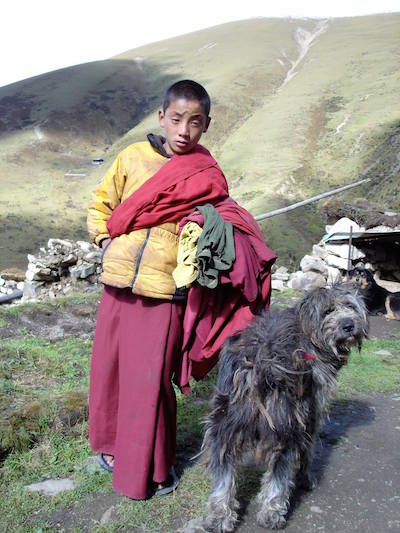
We suppose that entering a monastic life in Tibet was different for each individual, but we came across an account we found fascinating. In every Tibetan family that had five sons or more, one was compelled by law to be a lama, or monk, and this was never more compulsory than when a child exhibited any of the “sacred signs of Buddha.” At the age of seven, a child was placed in a lamasery chosen by their parents, and it was typically one nearest the town where they lived. Their child remained there the rest of his or her life – and yes, we said “her. In some regions of Tibet, lamaseries exited for women. They were far outnumbered by those for men, but both genders were bound by the strictest vows of celibacy and chastity.
One can only presume that the Tibetan Terriers bred and kept as companions and watchdogs by the Lamas for over 2,000 years became close companions, particularly since Tibetan Buddhism holds that dogs are the last reincarnation before rebirth as human. Dogs that didn’t live in the lamasery, but in packs around the monasteries survived from handouts by the monks. TTs that did live with the monks served as all-round herding dogs and protectors. The monks treated these dogs with the highest respect, almost as if they were children – perhaps one reason the dogs were often called “the little people” by the villagers. They were believed to be a good luck symbols for traveling, and accompanied nomadic herdsmen throughout the rough terrain of their native land.
The breed also herded the village’s livestock, and in the summer, their coats would be shorn and mixed with sheep wool to create clothing worn by families of the village. The Tibetan Terrier was therefore a valuable and contributing member of society in not just in lamaseries, but in small Tibetan villages.
Photo shared by Cynthia Dodson was taken of a young monk and his dog in 2005 at the Lingzhi Dzong in Bhutan very close to the border with Tibet.

It seems that the Lhasa Apso dogs are missing in the story. Usually, due to their excellent hearing and similarity to Buddha’s dog the Lhasas were the watchdogs living in the temples. When they gave alarm, the Tibetan Mastiffs came to take care of the uninvited guests. Older pictures show the Dalai Lama with Lhasas who were exquisite presents to honored guests as symbols of luck. TT were more herd guarding dogs. This may be worth adding.